Top 10 Animals with Sexual Dimorphism
Sexual dimorphism is the condition where there's a dramatic difference between sexes - such as color, size, ornamentation, shape or behavior.Sometimes males and females look so different that you might mistake them for different species.
Usually males look more spectacular than females because in the competition over mates, females prefer bigger and more elaborate males and females select against males that are dull in color.
In human society things are inverted - usually females wear more colorful and ornamented clothes, and makeup. Males are still bigger in size though.
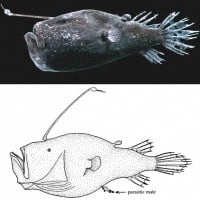
It's a type of Anglerfish. This is probably the most dramatic example of sexual dimorphism - males may be several orders of magnitude smaller than females.
The length of females is about 30 cm (12 in), of males - 1.05 cm (0.41 in).
Males attach to females near the vent and live on them parasitically.
In the lower image, the arrow points the tiny male and the small letters read "parasitic male". You can see the proportion.
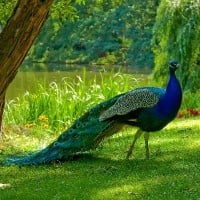 The peafowl include two Asiatic bird species (the blue or Indian peafowl originally of India and Sri Lanka and the green peafowl of Myanmar, Indochina, and Java) and one African species (the Congo peafowl native only to the Congo Basin) of bird in the genera Pavo and Afropavo of the Phasianidae family,... read more
The peafowl include two Asiatic bird species (the blue or Indian peafowl originally of India and Sri Lanka and the green peafowl of Myanmar, Indochina, and Java) and one African species (the Congo peafowl native only to the Congo Basin) of bird in the genera Pavo and Afropavo of the Phasianidae family,... read more This is the male (in the image).
Females have no the prominent tail. They have a subdued brown coloration. Females are still very beautiful birds though.
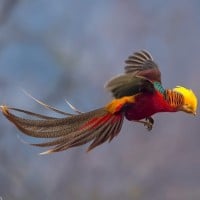
What you see in the image is the male. Females are much smaller and have no ornamental crests and wattles, and long tails. Females are with dull colors and look like the most ordinary beige farm chicken.
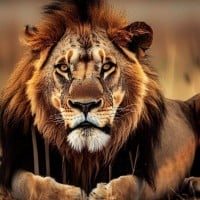 The lion (Panthera leo) is a large cat of the genus Panthera native to Africa and India. It has a muscular, broad-chested body, short, rounded head, round ears, and a hairy tuft at the end of its tail. It is sexually dimorphic; adult male lions are larger than females and have a prominent mane. It is... read more
The lion (Panthera leo) is a large cat of the genus Panthera native to Africa and India. It has a muscular, broad-chested body, short, rounded head, round ears, and a hairy tuft at the end of its tail. It is sexually dimorphic; adult male lions are larger than females and have a prominent mane. It is... read more You see the male in the image. Females don't have the prominent bushy mane.
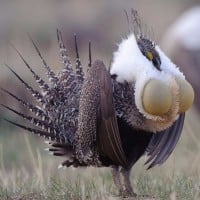
It's a male in the image here. The male is much bigger and looks more...bizarre.
The male has two inflatable gular sacs that are used to attract mates - the male just inflates them.
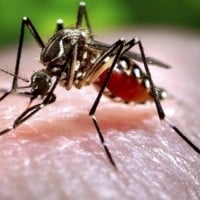 Spanish for "small fly," mosquitoes are insects that have been known to cause various diseases. A sample of diseases caused by mosquitoes: malaria, yellow fever, Chikungunya, West Nile virus, dengue fever, filariasis, Zika virus.
Spanish for "small fly," mosquitoes are insects that have been known to cause various diseases. A sample of diseases caused by mosquitoes: malaria, yellow fever, Chikungunya, West Nile virus, dengue fever, filariasis, Zika virus. Only females are bloodsuckers! Males are not. They are on a different diet.
Females have different and very specialized blood-sucking mouthparts.
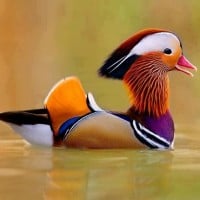
Again, this is the male you see. Females do not have this rich coloration. Females are dull and have a different shape because females don't have a crest and the tail is different, I.e. ordinary bird tail.
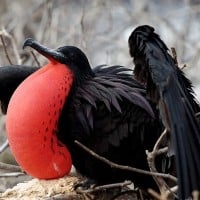
Males have a distinctive red gular pouch (aka throat pouch) - it's an area of featherless skin on the neck. Males inflate this pouch into a huge red balloon during the breeding season/courtship to attract females.
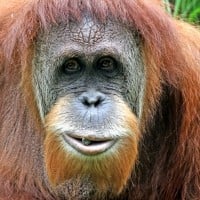 Orangutans are great apes native to the rainforests of Indonesia and Malaysia. They are now found only in parts of Borneo and Sumatra, but during the Pleistocene they ranged throughout Southeast Asia and South China. Classified in the genus Pongo, orangutans were originally considered to be one species... read more
Orangutans are great apes native to the rainforests of Indonesia and Malaysia. They are now found only in parts of Borneo and Sumatra, but during the Pleistocene they ranged throughout Southeast Asia and South China. Classified in the genus Pongo, orangutans were originally considered to be one species... read more I am almost sure it's a female in the image. Male orangutans have enlarged cheek flaps and a throat pouch. More dominant males have bigger flaps.
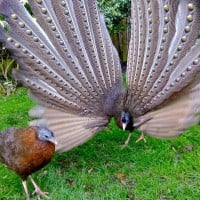
In the image you see (from left to right): female, male. Big difference.
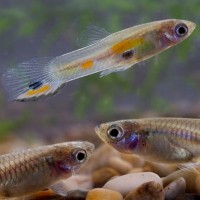
Male guppies have colorful spots and ornamentation while females are grey in color.
In the image here, the upper fish is the male. The other 2 are females.
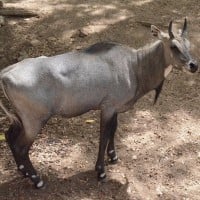
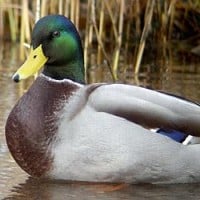
This is the male - it has a green head. Females don't have the great green coloration.
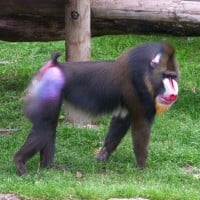
This is a male (in the image). The female Mandrill is much smaller and has no bright exotic coloring.
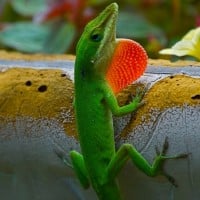
Green Anole, aka Carolina anole, is a lizard and male anoles (in the image) have a retractable gular fold that is used to attract mates.
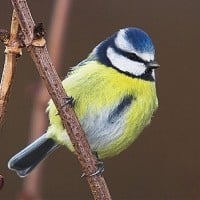
Males are "more yellow" than females.
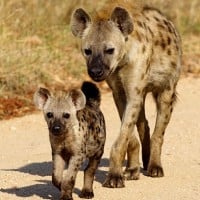 Hyenas or hyaenas are any feliform carnivoran mammals of the family Hyaenidae /haɪˈɛnᵻdiː/. With only four extant species, it is the fifth-smallest biological family in the Carnivora, and one of the smallest in the class Mammalia.
Hyenas or hyaenas are any feliform carnivoran mammals of the family Hyaenidae /haɪˈɛnᵻdiː/. With only four extant species, it is the fifth-smallest biological family in the Carnivora, and one of the smallest in the class Mammalia.